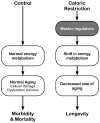Caloric restriction and aging: studies in mice and monkeys
- PMID: 19075044
- PMCID: PMC3734859
- DOI: 10.1177/0192623308329476
Caloric restriction and aging: studies in mice and monkeys
Abstract
It is widely accepted that caloric restriction (CR) without malnutrition delays the onset of aging and extends lifespan in diverse animal models including yeast, worms, flies, and laboratory rodents. The mechanism underlying this phenomenon is still unknown. We have hypothesized that a reprogramming of energy metabolism is a key event in the mechanism of CR (Anderson and Weindruch 2007). Data will be presented from studies of mice on CR, the results of which lend support to this hypothesis. Effects of long-term CR (but not short-term CR) on gene expression in white adipose tissue (WAT) are overt. In mice and monkeys, a chronic 30% reduction in energy intake yields a decrease in adiposity of approximately 70%. In mouse epididymal WAT, long-term CR causes overt shifts in the gene expression profile: CR increases the expression of genes involved in energy metabolism (Higami et al. 2004), and it down-regulates the expression of more than 50 pro-inflammatory genes (Higami et al. 2006). Whether aging retardation occurs in primates on CR is unknown. We have been investigating this issue in rhesus monkeys subjected to CR since 1989 and will discuss the current status of this project. A new finding from this project is that CR reduces the rate of age-associated muscle loss (sarcopenia) in monkeys (Colman et al. 2008).
Figures



References
-
- Ahima RS. Adipose tissue as an endocrine organ. Obesity (Silver Spring) 2006;14(Suppl 5):242S–249S. - PubMed
-
- Barger JL, Kayo T, Pugh TD, Prolla TA, Weindruch R. Short-term consumption of a resveratrol-containing nutracuetical mixture mimics gene expression of long-term caloric restriction in mouse heart. Experimental Gerontology. 2008a (epub ahead of print) - PubMed
-
- Barger JL, Kayo T, Vann JM, Arias EB, Wang J, Hacker TA, Wang Y, Raederstorff D, Morrow JD, Leeuwenburgh C, Allison DB, Saupe KW, Cartee GD, Weindruch R, Prolla TA. A low dose of dietary resveratrol partially mimics caloric restriction and retards aging parameters in mice. PLoS ONE. 2008b;3:e2264. - PMC - PubMed
Publication types
MeSH terms
Substances
Grants and funding
LinkOut - more resources
Full Text Sources
Medical

